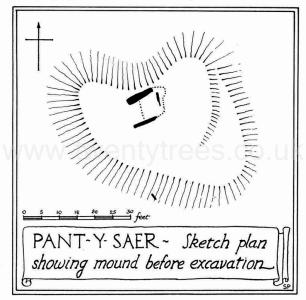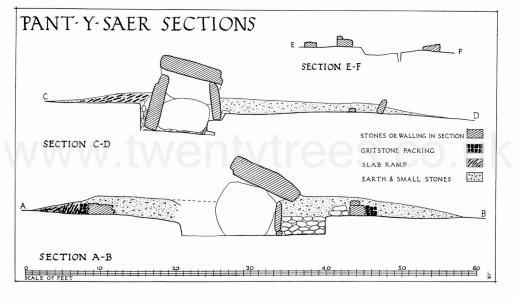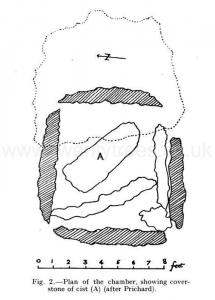Archaeologia Cambrensis 1933 Pages 185 228
Archaeologia Cambrensis 1933 Pages 185 228 is in Archaeologia Cambrensis 1933.
The Chambered Tomb Of Pant-Y-Saer [Map], Anglesey. By W. Lindsay Scott, F,S.A.Scot.
The chambered tomb of Pant-y-saer stands in latitude 530 18' 3" N. , longitude 40 14' 15" W. , on the outskirts Of the village Of Tvnygongl and about a mile distant from the northern end of Red Wharf Bay. This sandy bay on the east coast of Anglesey provides good shelter in westerly winds: and in such conditions is a safe place for hauling up boats. The lower land around it is reasonably fertile and the situation is not unattractive for settlement and distinctly advan- tageous for sea-raiders seeking a base for operations on the north coast of Wales.

The tomb stands on a limestone plateau, thinly and partially covered with turf, which slopes gently to the east and south. Immediately to the west the land rises in a small rocky knoll, which is the highest point in the neighbourhood and stands at 300 feet above sea level. The view from the tomb is, therefore, limited on the north and west but extends on the east and south to the Great Ormes Head and the mountains of Wales.
Before excavation the tomb presented those enigmatic features which excuse, if thev do not justify, the statement in our text books that there are dolniens in M'ales. To north and south stood large orthostats of much weathered limestone, to the east a smaller limestone slab, to the west five blocks of various sizes which, as our predecessors would have said, "rested in some confusion". Making a generous allowance for the confusion, one of these might have been imagined to have provided, with the north and south slabs, the " three points on which the massive table stone was artificially poised." The " massive table stone," weighing some twenty tons, did in fact rest on the north and south orthostats but it was heavily tilted to the east and its eastern edge rested on the turf. It was evident on inspection that the western end of this capstone, which was composed of badly weathered limestone, had split off and that some at least of the five western blocks were fragments fallen from it.
Around the tomb a mound stood to a maximum height of '21 feet above the limestone plateau, and it was this mound which suggested the advantage of excavation to my friend Mr. W. J. Hemp, F.S.A. TO him I owe my introduction to this tomb and much valuable advice and encouragement during the course of its excavation. The periphery of this low mound was very indefinite; so far as it could be determined it is shown in Fig. 1 If a very shallow extension to the south-east were disregarded as due to earlier excavation or digging for building stones, the plan might be said to be a broad oval with a crescentic concavity on the north. Just within the south edge was a limestone slab standing in a heavily tilted position. Immediately to the west and south-east of the chamber were hollows which were evidently recent.

This leads me to the unhappily necessary task of referring to the previous excavations of the tomb. Following the digging of some treasure seekers " in 1874, who reported the finding only of bones, excavation was undertaken in the same year by the Rev. Wynn Williams and Messrs. T. and R. Prichard. A report by Mr. T. Prichard is to be found in Archaeologia Cambrensis, 1875, pages 344—348, accompanied by two plans, which I reproduce here (Figs. 2 and 3) together with a sketch (Fig. 4), which Mr. Stuart Piggott has very kindly made for me, showing a north to south section of the chamber reconstructed from the description and measurements given in the report.

It is wiser in archaeology to lose alleged facts, which may well be true, than to build on statements, which may equally possibly be false, and a considerable economy of belief is advisable in handling Prichard's paper. I do not think, however, that it would be a reasonable scepticism to disregard the principal allegation of these excavators, namely that, set diagonally from N.W. to S.E. within the chamber, was a cist 4 ft. 4 in. long by I ft. 2 in. wide floored walled up at with a pavement 6 in. deep of " sea shore pebbles, the sides and ends with rubble, the north-west end being rounded and covered by a " flat stone which we ascertained to be 6 ft. long, 2 ft. 3 in. across the broad and I ft. 9 in. at the narrow end, with a thickness of 7 in." Before attempting to raise this stone we carefully scraped away the earth from the sides and took a peep under it, when we perceived a heap of bones that had to all appear- ance not been disturbed by the hand of man since their original deposition within the grave." Turning over the cover slab it became evident that the stonework wheleon the slab originallv rested had been too weak and had given way, thereby causing the remains below to be to a certain extent crushed ; and this may also account for the position of certain leg bones which we found lying partly beneath and partly outside the tomb at its north-west end." The relative position of the bones at the rounded end of the grave " was as in Fig. 3 ; they included two skulls and " as far as we could judge the bodies were originally placed sitting, or more probably lying sideways with the knees drawn up." No grave goods are recorded and the only other objects specifically stated to be found within the cist were " a quantity of dry stuff like coarse sand, which, on examination, proved to be comminuted mice and rat bones."
